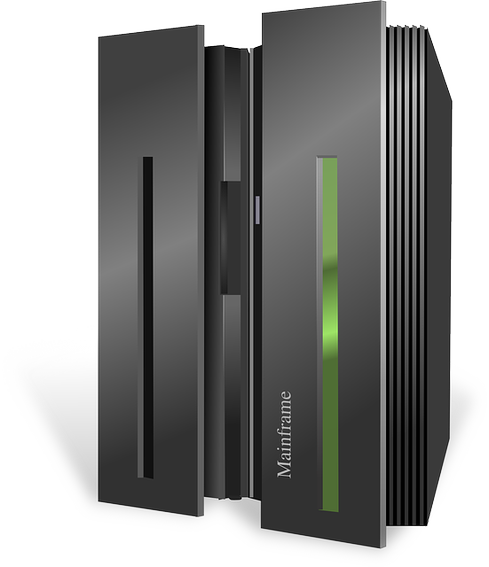This year marks the 50th anniversary of the mainframe computer, and many years after the mainframe’s predicted demise, industry leaders still depend on "big iron" to run many of their core business processes. Ninety-six of the world’s top 100 banks and 90% of the world’s largest insurance companies still use mainframes, according to SHARE Inc.
Every indication is that the mainframe will remain vital to business operations for years to come. For example, a 2014 Vanson Bourne survey of global 590 CIOs and IT directors showed that respondents expect their organizations to continue relying on mainframe applications for another 10 years. At the same time, there's a push within the enterprise to identify how today’s modern mainframe capabilities can be utilized in mobile and cloud environments.
Benefits of the modern mainframe
The modern mainframe is virtually unrecognizable compared to its predecessor from decades ago. Today’s iteration can handle far larger quantities of data, process vast application estates, support a cloud infrastructure, and provide unprecedented levels of flexibility and return on value.
With these capabilities, IT teams can shift from “keeping the lights on” to “stealing a march” from competitors by utilizing the mainframe as an enabler of disruptive technologies.
Making mainframe applications available in a cloud environment allows enterprises to provide Internet-based access to the application’s data and functions, improved scalability and stability, an expanded customer base through Software-as-a-Service (SaaS), and reduced up-front and ongoing project costs by outsourcing to a cloud provider.
On the mobile side, benefits include the ability to build vibrant user interfaces and deliver a better user experience, better consumer service, and the ability to expand access to mainframe applications via the use of mobile devices.
Challenges facing the modern mainframe
However, the Vanson Bourne survey, which Micro Focus commissioned, underscores challenges (both perceived and real) that organizations face in achieving these benefits. More than half of respondents indicated that it's difficult or impossible to develop mainframe applications for mobile devices or the cloud, and less than one fifth describe developing mainframe apps for mobile/cloud as simple.
What are some of these challenges? Extending access to core business applications must be done without placing an additional burden on the overworked development teams or compromising the resilience of the mainframes. Furthermore, organizations are grappling with a lack of workers with mainframe skills, and making legacy infrastructure compatible with modern methods of delivery.
Extending mainframe applications
While there are challenges, the Vanson Bourne survey indicates a shift is underway. Only around one-third of mainframe applications are accessible on mobile devices and/or via the cloud at present, but respondents indicate that this percentage will increase in two years’ time. As more organizations extend mainframe applications to the cloud and mobile, here are five key strategies to consider:
1. Don't overlook the end user experience. The modern mainframe’s advances have not translated into a markedly improved user experience. Before extending mainframe applications to the cloud and mobile in particular, organizations must recognize that users will bring their consumer-grade expectations along with them, including all the features and controls of modern mobile and desktop environments.
Ensure a compelling user experience through a phased approach and piloting the effort with a controlled group to secure quick, high-impact wins within the organization.
2. Re-use existing business applications and processes. A prevailing assumption is that adapting applications for mobile and cloud environments requires a rip-and-replace approach that can add significant costs and risks, and delay time-to-deployment. Before abandoning considerable investments in existing systems, an organization should identify core business assets (services) that should be repurposed for cloud and mobile environments, such as IaaS, PaaS, and SaaS.
For example, technology exists today to re-host the mainframe application “as is” to distributed/server-based environments, and generate these services from mainframe code/functions.
3. Automate testing of mobile and cloud apps. By moving application testing for mobile, web and related back-end systems to a cost-effective environment that is easy to use, testing phases can be completed faster and more thoroughly without eating into mainframe power. Automated test tools can help here.
4. Audit workload deployment strategy. Creating more endpoints and activity through the extension of applications to mobile introduces potential activity spikes. This is a costly approach, because, for example, mainframe systems may exceed $4,000 per MIPS. Organizations must look to optimize workload-using redeployment and seize the advantage of the choice of platforms in zEnterprise or other servers to free up precious mainframe capacity.
5. Modernize development. For mainframe applications that have been re-hosted to servers, cloud environments, and mobile interfaces utilize modern IDEs such as Eclipse and Visual Studio (even for applications developed using COBOL, PL/I, JCL, etc.). This reduces the need for specialized mainframe development skills and development MIPS/Cost, and this modernization can be done even if the application remains on the mainframe.









